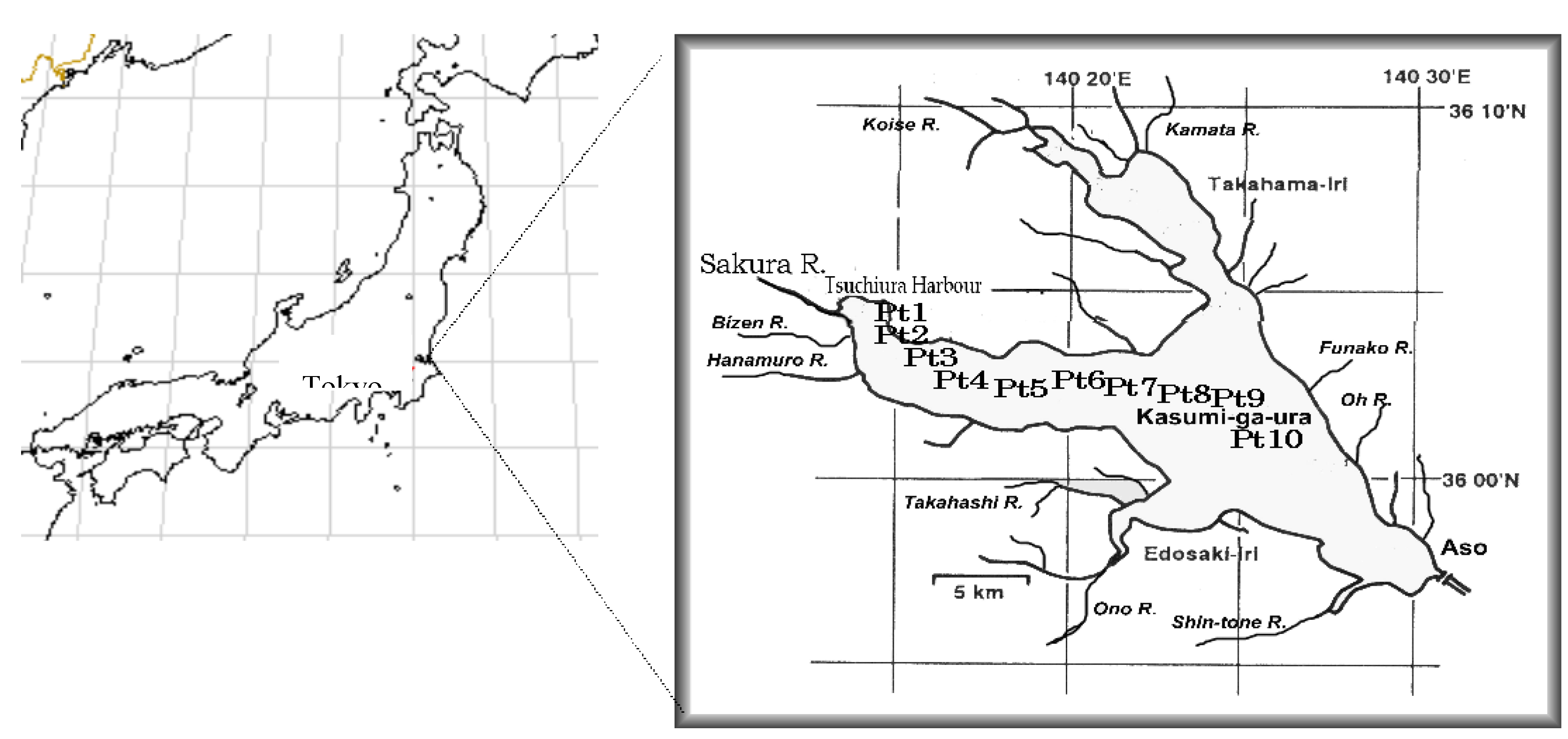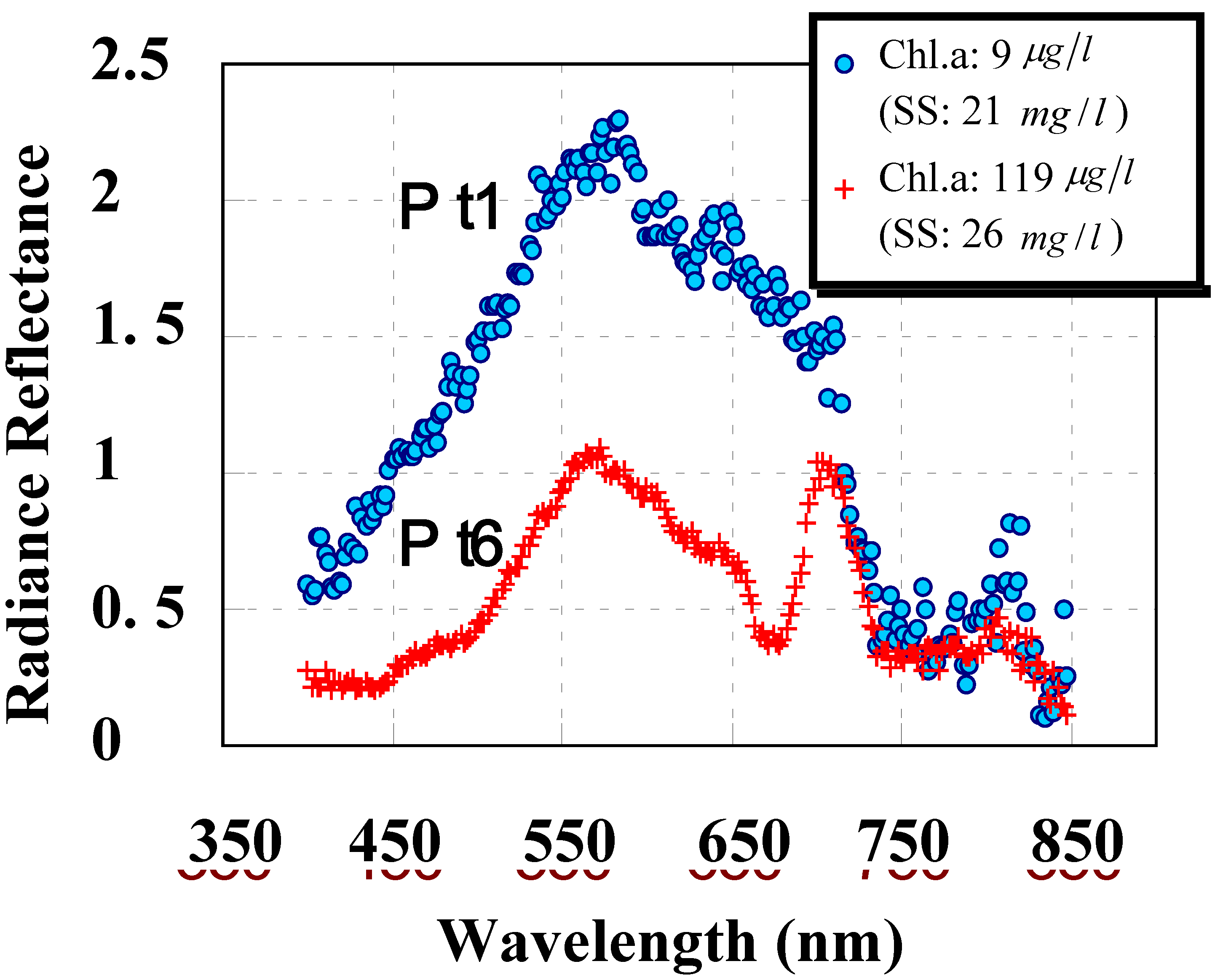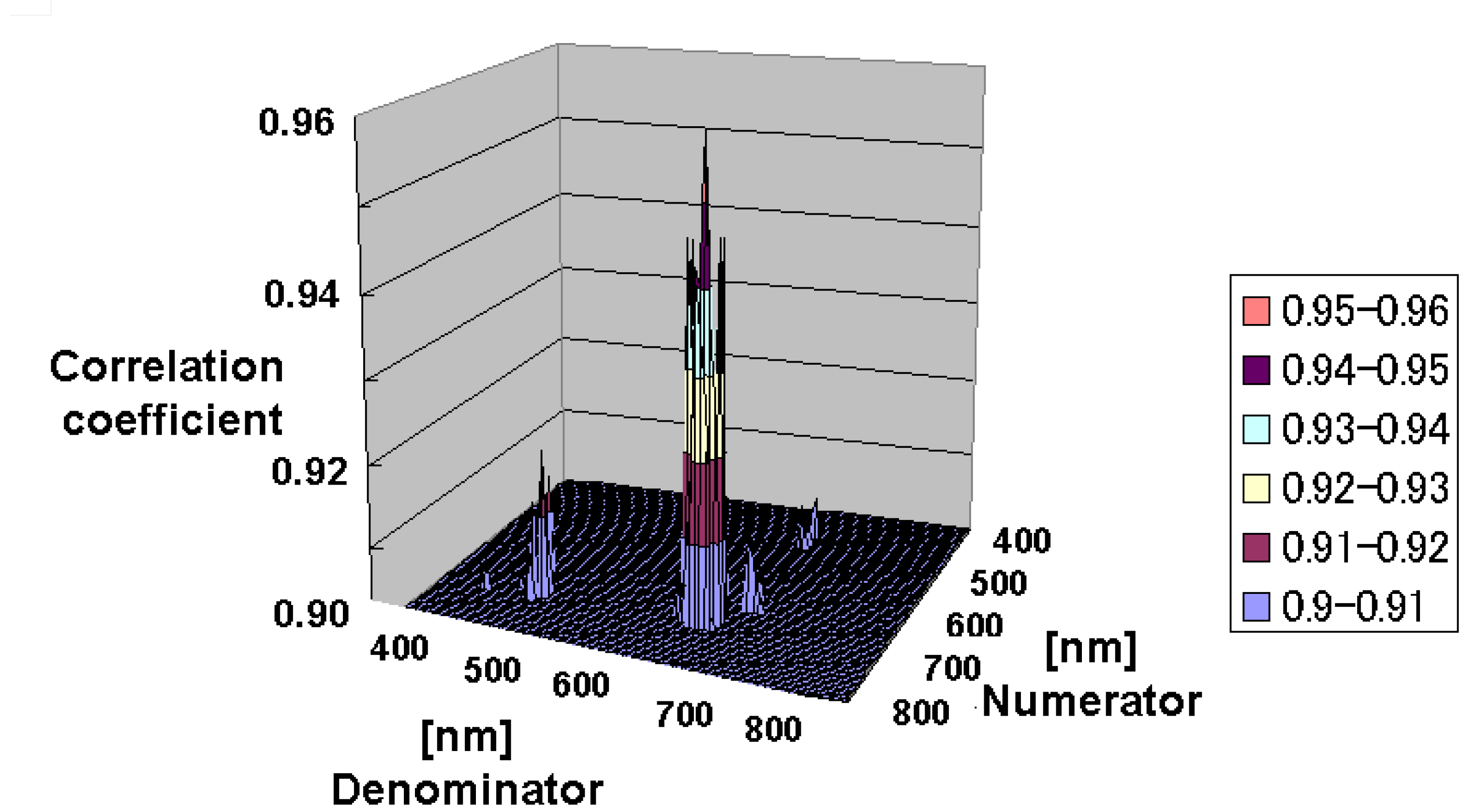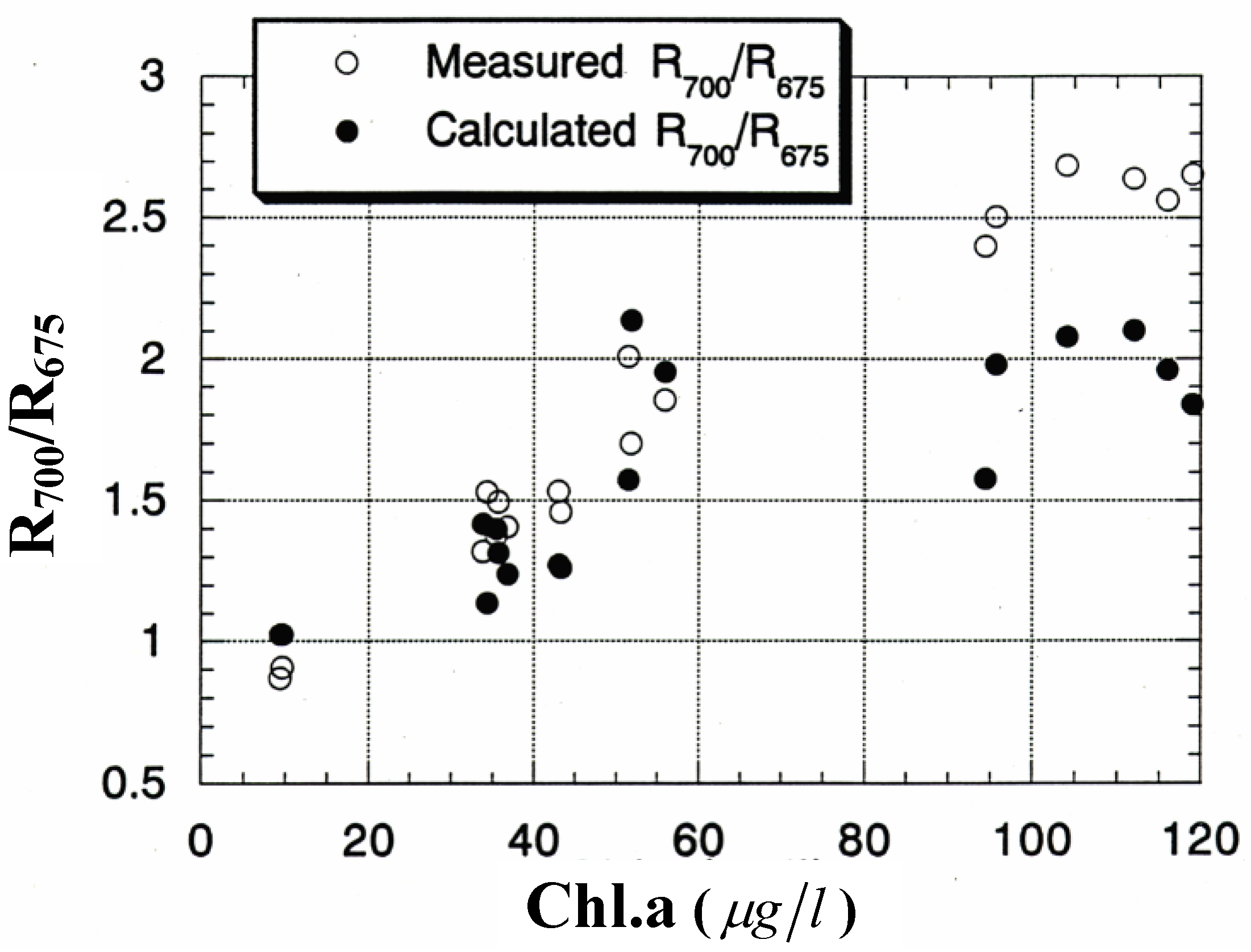1. Introduction
A number of spectral vegetation indices have been developed [
1,
2]. General vegetation indices such as the Simple Ratio Index (SR) can be calculated using the ratio of spectral reflectance at two different wavelengths, with a red light region as the denominator and a near infrared region as the numerator. The Normalized Difference Vegetation Index (NDVI), which is the most common vegetation index, is calculated from the ratio using spectral reflectance at two different wavelengths. These indices are very simple and applicable for estimating chlorophyll-a in leaves or amount of vegetation. The NDVI is more sensitive to biophysical than biochemical properties and is known to become saturated at a relatively low biomass. Also, it has been reported that the ratio of spectral reflectance at two different wavelengths correlated well with the chlorophyll concentration in lakes or inland seas polluted by many particles [
3,
4,
5,
6,
7]. Using data measured at 29 points of Lake Kasumigaura in Japan, Oki
et al. [
8,
9] analyzed the distribution of correlation coefficients greater than 0.9 in three-dimensional space with the denominator and numerator of the ratio of spectral radiance reflectance, which is the ratio of the upward radiance to the downward irradiance, R
w at two different wavelengths. The relationship between the ratio (R
w725/R
w675), which is calculated from the spectral radiance reflectance of 675 nm and 725 nm, and the chlorophyll-a concentration showed the best correlation of all patterns within the range of 400 nm through 850 nm. The correlation coefficient was 0.958 under various conditions in which each point was measured on different dates. It has generally been considered effective to use the wavelength ranges of chlorophyll-a-absorbing light (red light region) and strongly reflected light (near infrared region) in leaves. However, it has not been clearly explained why the chlorophyll-a concentration in leaves or in bodies of water can be precisely estimated.
In this study, I attempted to determine why the ratio of reflectivity is effective for the chlorophyll-a estimation. Lake Kasumigaura in Japan was selected as the test site because a lot of data on the lake, such as the chlorophyll-a concentration and spectral signature, has already been obtained.
2. Radiative Transfer Model at the Water Surface
The underwater light field is determined by the inherent optical properties such as the absorption coefficient and scattering coefficient of the various components in the water body. Thus, upward radiance of light from the water body contains information on the components.
Figure 1 shows a schematic diagram of an optical system above and below a water surface. The spectral radiance reflectance
R of radiance to irradiance at the water surface is defined by
where
Lt is the upward spectral radiance from the water surface,
Ed is the downward irradiance onto the water surface from total solar radiation, and
Lw is the upward spectral radiance just above the water surface.
Lr is the upward spectral radiance reflected from the water surface due to total solar radiance.
Ei and
Es are the downward irradiance onto the water surface due to direct sun and the diffused skylight, respectively. In this study, it was assumed that the water body is a Lambertian reflector and the angular distribution of radiance in the lower hemisphere of the water surface is uniform for radiance traveling upward. In this case,
Lw can be expressed as
where
t and
n are the transmittance and refractive index from water to air, respectively.
Lu(0) is the upward spectral radiance just below the water surface, which cannot be measured directly. Therefore,
Lu(0) was estimated from the upward radiance at the depth of
Z as
where
k is the extinction coefficient for the upward irradiance of the water [
3,
10,
11], expressed as
In this study, by measuring upward spectral radiance underwater at depths of
Z1 and
Z 2, we defined the spectral radiance reflectance
Rw as the following equation instead of Equation (1):
Equation (7) removed the effect of specular reflection Lr at the water surface in Equation (2), which gave a more accurate measurement for the chlorophyll-a concentration in the water body.
Figure 1.
Schematic diagram of an optical system above and below the water surface.
Figure 1.
Schematic diagram of an optical system above and below the water surface.
3. Measurement of the Spectral Signature
The upward radiance of Lake Kasumigaura, selected as a test site for this study, was measured by using a field spectroradiometer developed by Miyazaki
et al. [
12] Measurements were taken at the water surface and at several depth layers at each point (Pt1 to Pt10) shown in
Figure 2. There were 29 sample points, of which 10 points at Pt1 to Pt10, six points at Pt1 to Pt6, two points at Pt1 to Pt2, eight points at Pt1 to Pt8, and three points at Pt1 to Pt3 were measured on 10 September 1993, 22 April 1994, 27 July 1994, 4 September 1996, and 5 September 1996, respectively.
Figure 2 shows locations of Pt1 to Pt10 at Lake Kasumigaura. The measurements covered the range from 400 nm to 850 nm with a resolution of 2 nm. At each measurement point, the following were measured:
• Upward spectral radiance underwater at depths of 10 cm and 40 cm from the water surface ( Lu(0.1), Lu(0.4))
• Spectral irradiance of the white board (Ed)
The obtained spectral signature of water was determined by taking an average of 10 scans. The upward spectral radiance (
Lu (0.1),
Lu (0.4)) of the underwater was measured once (average of 10 scans). Then, two liters of surface water of the lake was collected at each point to measure the chlorophyll-a concentration by a methanol extraction method where 10 ml methanol was added on a glass filter on which the suspended substances had been filtered, and then the soluble substances were extracted by keeping the mixture at a temperature of less than 3 degrees Celsius for 12 hours [
13].
Figure 2.
Locations of Pt1 to Pt10 at Lake Kasumigaura.
Figure 2.
Locations of Pt1 to Pt10 at Lake Kasumigaura.
Figure 3 shows examples of spectral reflectance calculated just above the water surface of Lake Kasumigaura at Pt1 measured on 10 September 1993 and Pt6 measured on 22 April 1994.
Figure 3.
Spectral reflectance calculated just above the water surface at Pt1 measured on 10 September 1993 and Pt6 measured on 22 April 1994 of Lake Kasumigaura. Chl.a = chlorophyll-a; SS = Suspended Solids concentration.
Figure 3.
Spectral reflectance calculated just above the water surface at Pt1 measured on 10 September 1993 and Pt6 measured on 22 April 1994 of Lake Kasumigaura. Chl.a = chlorophyll-a; SS = Suspended Solids concentration.
4. Chlorophyll-a Estimation Using the Ratio of the Reflectivity
Various methods for estimating chlorophyll concentration have been developed [
3,
4,
5,
6,
7,
14,
15]. In many of these methods, the ratio of spectral reflectance at two different wavelengths is well correlated with the chlorophyll concentration at lakes or inland seas polluted by many particles [
3,
4,
5,
6,
7]. Oki
et al. [
8,
9] analyzed the distribution of correlation coefficients at Lake Kasumigaura, which is greater than 0.9, in three-dimensional space with the denominator and numerator of the ratio of spectral radiance reflectance at the two different wavelengths shown in
Figure 4. In the study, the spectral radiance reflectance of Equation (7) was calculated at 5 nm intervals from Equation (4) using anteroposterior values of the spectral radiance data of the 29 samples shown in this study. To estimate the chlorophyll‑a concentration in water like that in Lake Kasumigaura, it is better to use the ratio of spectral radiance reflectance at two different wavelengths, that is, using the red light region around 675 nm as the denominator and the near infrared region within the range of 700 nm through 730 nm as the numerator, than to use the other ratio of spectral radiance reflectance shown in
Figure 4. The estimation results of the chlorophyll-a concentration using these wavelengths were similar to those obtained by Hoogenboom
et al. [
7], who developed a remote sensing algorithm for estimating the chlorophyll-a concentration in eutrophic inland waters. The red light region around 675 nm can be explained by the absorption of chlorophyll-a. However, the effectiveness of using the range of 700 nm through 730 nm has not been confirmed.
Figure 4.
Distribution of correlation coefficient in the three dimensional space.
Figure 4.
Distribution of correlation coefficient in the three dimensional space.
5. Why It Is Effective to Estimate the Chlorophyll Concentration with the Ratio of Spectral Radiance Reflectance
The spectral radiance reflectance of a water body derived from the two-flow model by Morel
et al. [
14] has been used by many researchers. The spectral radiance reflectance
with wavelength
can be expressed as follows:
where
and
are the absorption coefficient and backscattering coefficient with wavelength
, respectively. The
and
can be expressed as
where the subscripts
,
, and
indicate the coefficients for pure water, suspended solids except for chlorophyll-a, and chlorophyll-a.
In this study, using the ratio of spectral radiance reflectance of 675 nm and 700 nm as the red light region and near infrared region from the ratio of spectral radiance reflectance shown in
Figure 4, is effective for estimating the chlorophyll-a concentration in theory using a two-flow model.
The following was assumed:
Assumption 1: Water polluted by many particles can be expressed as
Assumption 2: In this study, it was assumed that if two wavelengths are closer, then the dependence on backscattering coefficients is more constant, which can be expressed as follows:
From Assumptions 1 and 2, Equation (9) can be rewritten as follows:
The absorption coefficient,
, for chlorophyll-a of Equation (10) is considered to be linearly related to the chlorophyll-a concentration
, that is,
where
is the absorption coefficient per unit of chlorophyll-a concentration. Using Equations (8) through (12), the chlorophyll estimation model can be expressed as
From Equation (13), it can be seen that all of the backscattering coefficients can consequently be ignored by using the ratio of spectral radiance reflectance of 675 nm and 700 nm. In other words, Equation (13) can be expressed by using only absorption coefficients, which are more stable for measurement in comparison with using backscattering coefficients.
In Equation (13), the values of
and
were calculated from the following equations by Okami
et al. [
3]:
where
SS is the suspended solids concentration, which was measured at the same points as the chlorophyll-a concentration in this study. In Equation (13), the values used for
,
, and
were as reported by Morel
et al. [
14], and the values for
and
were adopted from Smith [
16].
Figure 5 shows a comparison between the chlorophyll-a concentration and the R
700/R
675 value calculated from Equation (13) and the measured R
700/R
675 value. It was found that the calculated R
700/R
675 was in accord with the measured R
700/R
675 when the chlorophyll-a concentration was less than 60 μg/l. However, the values were not in accordance with each other when the chlorophyll-a concentration was greater than 90 μg/l. One reason might be that assumption 2 doesn’t hold well because the value of
decreases relatively in comparison with the value of
with the increase in chlorophyll-a concentration. As a result, the band ratio cannot be expressed by Equation (13), which is only composed of absorption coefficients, as no backscattering coefficients were used. In other words, band selection is crucial for producing the band ratio when the chlorophyll‑a concentration is estimated without the effects of backscattering. In general, we can infer that assumption 2 holds well when the two selected wavelengths must be close, but one must be the absorption range of chlorophyll-a as the spectral radiance reflectance of 675 nm, and the other must be outside of the absorption range of chlorophyll-a as the spectral radiance reflectance of 700 nm, to estimate chlorophyll-a concentration accurately. Also, the effective estimation range of chlorophyll-a concentration can be lower when the two selected wavelengths are more distant than those of the test case in this study.
Figure 5.
Comparison between chlorophyll-a concentration and R700/R675 value calculated from Equation (13) and R700/R675 value measured.
Figure 5.
Comparison between chlorophyll-a concentration and R700/R675 value calculated from Equation (13) and R700/R675 value measured.
6 Conclusions
In this study, spectral measurement was carried out using Lake Kasumigaura as a test site to find out why the ratio of the reflectivity is effective for making a chlorophyll-a estimation. It was found that the chlorophyll-a concentration could be accurately estimated by using the ratio of spectral radiance reflectance at two different wavelengths, that is, with a red light region around 675 nm as the denominator and a near infrared region within the range of 700 nm through 730 nm as the numerator.
The reasons why it is effective to estimate the chlorophyll-a concentration with the ratio of spectral radiance reflectance at the red light region and near infrared regions were shown in theory using a two-flow model. It was found that all of the backscattering coefficients can consequently be ignored by using the ratio of spectral radiance reflectance at the red light and near infrared regions. In other words, the ratio can be expressed by using only absorption coefficients, which are more stable for measurement than backscattering coefficients. In addition, the band selection is crucial for producing the band ratio when the chlorophyll-a concentration is estimated without the effects of backscattering. In general, we can conclude that the two wavelengths selected must be close, but one must be within the absorption range of chlorophyll-a as the spectral radiance reflectance of 675 nm, and the other must be outside of the absorption range of chlorophyll-a as the spectral radiance reflectance of 700 nm, to accurately estimate the chlorophyll-a concentration.








